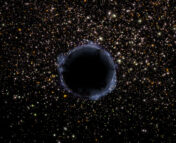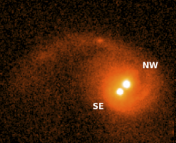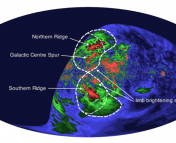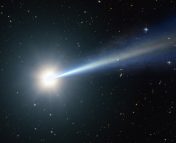Title: Observations of a black hole X-ray binary indicate formation of a magnetically arrested disk
Authors: Bei You, Xinwu Cao, Zhen Yan, Jean-Marie Hameury, Bozena Czerny, Yue Wu, Tianyu Xia, Marek Sikora, Shuang-Nan Zhang, Pu Du, Piotr T. Zycki
First Author’s Institution: Department of Astronomy, School of Physics and Technology, Wuhan University, Wuhan, China
Status: Published in Science [closed access]
From the awe-inspiring depiction in Interstellar, to the recent images of black holes that took the media by storm, we’ve gotten used to imagining black holes as powerful, solitary objects, around which both accretion disks and entire galaxies orbit. But in actuality, it’s not uncommon to find black holes – just like any other star or stellar remnant – orbiting around other stars in binary (or higher!) configurations. So much so that scientists even have names for specific kinds of binaries; for example, a ‘black hole x-ray binary’, or BHXRB, is a binary system that contains a black hole (BH from here on out) and a normal star, and emits large amounts of x-ray radiation. In systems like these, the BH accretes matter from the star, which accumulates onto a cold accretion disk, until the temperature at some part of the disk becomes high enough to trigger the ionization of hydrogen. This accretion process generates an outburst of x-rays as the disk becomes unstable and empties, and is also usually accompanied by jets of radio and optical light – though the mechanisms that generate these other kinds of radiation are not the same as the x-rays, and are still unclear.
Theories and simulations posit that in systems like these, any magnetic fields that are present in the accreting material can be dragged with it around the BH, increasing their strength. At some point, these magnetic fields can get strong enough that they equal the gravitational pull from the BH, stopping the flow of accretion altogether. This mechanism forms what is called a ‘magnetically arrested disk’, or MAD. While magnetic fields strong enough to generate MADs have been detected around BHs before, there has never been strong observational evidence for a MAD – until now, the authors of today’s paper believe.
Going ‘MAD’ With Power
‘MAXI J1820+070’ is a BHXRB containing a low-mass star (~0.5 solar masses, according to this paper) and a BH of ~8.5 solar masses (so not supermassive!). On March 11, 2018, an x-ray outburst was detected from this system, and numerous telescopes and instruments around the world recorded it. Today’s authors took archived x-ray observations of the system from the Insight-Hard X-ray Modulation Telescope, radio observations from the Arcminute Microkelvin Imager Large Array , and optical observations from the American Association of Variable Star Observers, and aim to show that a curious discrepancy in the observations can be answered by the formation of a MAD around the BH.
Figure 1 shows how the luminosity of the system changes in the three wavelength regimes over time. All three show a strong flare or peak, followed by a drop-off – but the three peaks are not aligned. The radio peak lags behind the x-ray flare by about 8 days, and the optical peak follows over 8.5 days after that. This implies that the three peaks occur due to different mechanisms occurring in the disk, rather than the same effect.

Up To Interpretation
The author’s interpretation of this temporal discrepancy goes as follows. The x-ray flare occurs due to the disk instability described above, while the radio emission comes in the form of a jet emitted by the BH. The jet’s strength is related to the strength of the magnetic field around the BH, so the growing radio emission over time supports the idea of magnetic fields following the accretion and growing in strength, as described by the MAD scenario. ~8 days after the x-ray flare, the field becomes strong enough to challenge the gravitational pull of the BH, and a MAD forms – this corresponds to the peak in radio emission. As the accretion has been stopped, so does the jet strength stop growing and eventually drops off. The authors’ calculations of the magnetic field strength and diffusion support this interpretation, and are consistent with theory.
The delay in the optical peak is a bit harder to explain. Simulations of the disk show a small optical flare would be produced around the time of the x-ray flare but would drop off much faster than the 16-17 day delay in the observations… unless one adds disk winds to the simulation. The authors postulate that disk winds could be launched during the flare, and when they took those into account, the simulation predicted the optical peak would lag the x-ray flare by over 15 days, which is consistent with the observations of the system.
All in all, unless a stronger interpretation of these observations comes around, it’s looking pretty likely that the concept of magnetically-arrested disks is moving from the realm of theory to an observationally-backed mechanism, strengthening our knowledge of the universe and the awesome objects that inhabit it. While the exact mechanisms of the formation of these emissions and signals may remain somewhat uncertain still, discoveries and interpretations such as these are the steps that lead towards an eventual understanding of even the most obscure processes in astrophysics.
Astrobite edited by: Clarissa Do O
Featured image credit: XMM-Newton / ESA / NASA.




